Phonics…phonemic awareness…phonological awareness…there are a LOT of terms to know if you teach reading in the primary grades!
It’s hard to keep it all straight.
But it’s also important to keep it all straight.
Teaching students to read is one of our most important jobs as teachers! And the more we know about how the English language works, the better we can teach reading to our students.
So in today’s post, I’ll explain exactly what the terms “phonics” and “phonological awareness” mean. I’ll also go over a whole lot of other related terms – everything from a digraph to a diphthong to a morpheme!
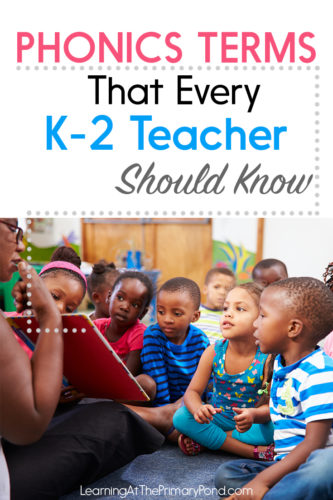
Just What is Phonics Anyway?
In my blog post What is the Science of Reading?, I talk about the importance of teaching phonics explicitly and systematically.
PHONICS focuses on the sound-symbol relationships used to read and write. When you teach phonics, you help your students attend to the sounds of language, the symbols of language, and the relationships between the two. (Phonics = connecting sounds and letters.)
And as you probably already know, a solid phonics foundation is essential to becoming a successful reader and writer.
Now let’s dig into into some more specific terms related to phonics!
But first…a little Greek lesson!
Here are a few Greek roots that will help you remember and make sense of all these phonics-related terms:
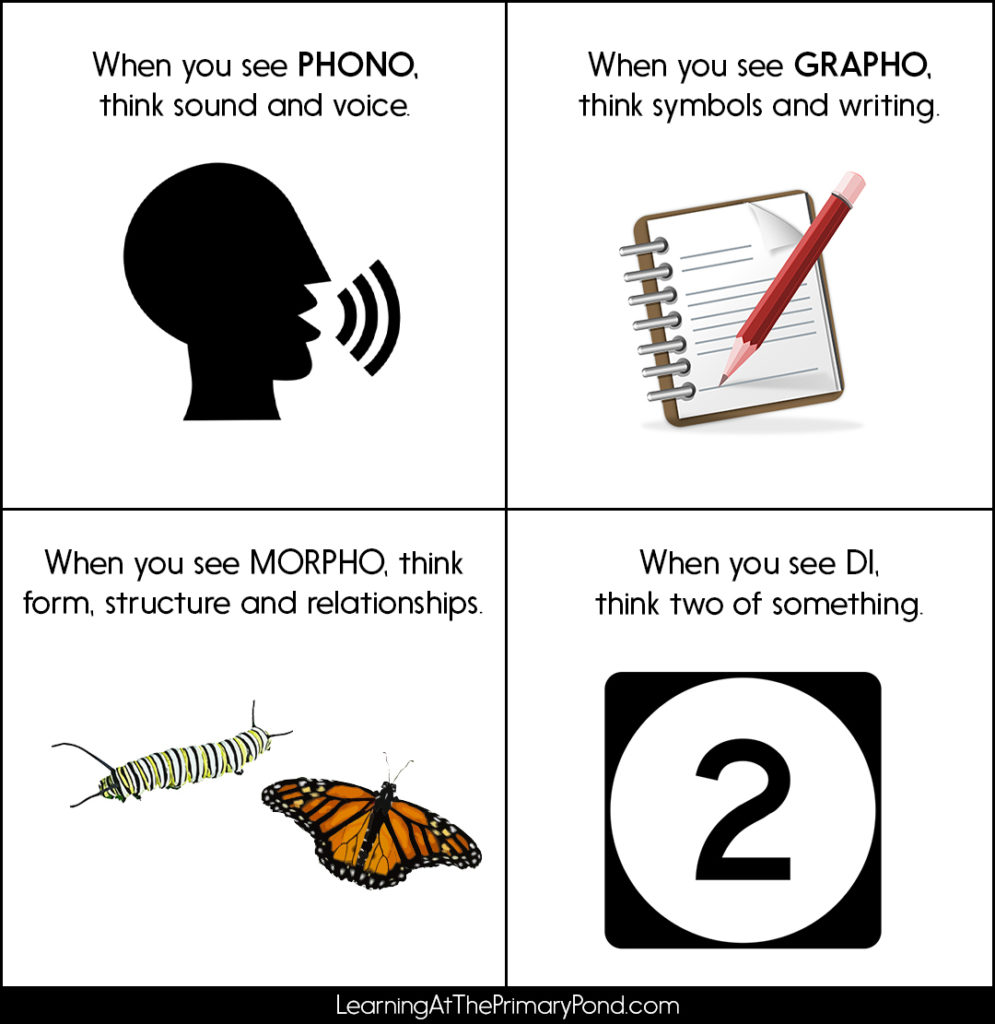
Phonemic Awareness vs. Phonological Awareness
“Phonemic awareness” and “phonological awareness” are two commonly-confused terms. Here’s how they differ – and what they have to do with phonics:
PHONEMIC AWARENESS focuses on the INDIVIDUAL SOUNDS of words. A phoneme (as we’ll talk about later) is the smallest unit of sound in a language. For example, if we think about the word “hop,” we can break that word up into the sounds /h/ /o/ /p/. Each one of those sounds is a phoneme. So phonemic awareness = awareness of phonemes, individual sounds. Some phonemic awareness skills include:
- Hearing the word turtle and naming the initial sound – /t/
- Hearing the word dog and segmenting it into these three sounds: /d/ /o/ /g/
- Hearing the word man, substituting the /f/ sound for the /m/ sound to get fan
PHONOLOGICAL AWARENESS is a broader category of knowledge and skills. Phonemic awareness is one type of phonological awareness. Some phonological awareness skills (in addition to phonemic awareness) include:
- Identifying the individual words in a sentence spoken aloud
- Identifying and generating rhyming words
- Separating words into onset and rime and combining onsets and rimes into words
- Separating words into syllables and blending syllables together to make words
In a nutshell, phonemic awareness is one (very important) type of phonological awareness skill.
And remember, phonics work incorporates written letters. Phonological awareness and phonemic awareness only deal with sounds.
But applying phonics knowledge to spell a word, for example, also requires students to use their phonological awareness / phonemic awareness skills. Kids hear the sounds in the word (phonemic awareness) and then translate those sounds to words on the page (phonics).
Kids need both phonological awareness and phonics instruction. They can be taught separately and together. And you don’t need to wait for a child to become more proficient in phonological awareness to begin working on phonics!
The Building Blocks
Next, I’m going to talk about some of the terms you might come across when reading about phonics or using a phonics program (like my phonics program, From Sounds to Spelling).
Phonemes, Graphemes and Morphemes
When you think about phonemes, graphemes and morphemes, think small…very small. These are some of the smallest units of language you work with in phonics.
PHONEME: One unit of sound in a syllable or word. The word man has three phonemes. The word beach also has three phonemes.
GRAPHEME: One or more letters that represent one sound. The (m) in man is a grapheme. The (ch) in beach is also a grapheme.
MORPHEME: The smallest part of a word that has meaning or influences the meaning of a word. The word wonderful has two morphemes (wonder) and (-ful). Adding (-ful) to the word (wonder) changes the meaning of the word, yet the words are still related.
From Units to Words
We put phonemes, graphemes, and morphemes together to make words!
Consonants, Vowels and CVC Words
The 26 letters of the English alphabet are divided into two groups: consonants and vowels.
They’re often marked as C for consonant and V for vowel. A CVC word is a Consonant Vowel Consonant word,. Words like man, pig and hat are all CVC words.
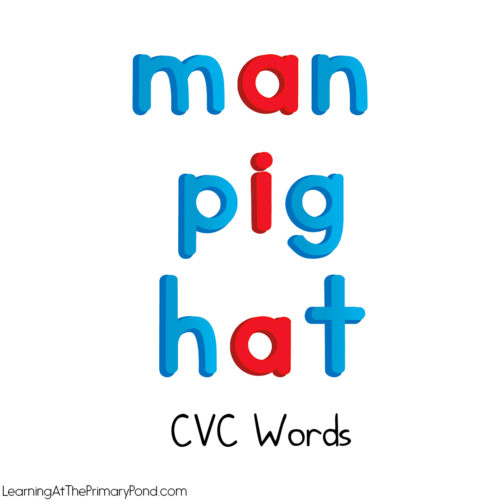
You might also see variations of this abbreviation, like CCVC (e.g. swim), CVCC (e.g. pond), or CVCe (e.g. lake).
In English there are 5 vowels: a, e, i, o, and u. Vowel sounds are considered LONG VOWELS when the sound matches the name of the letter (e.g. the a in cake). This is in contrast to SHORT VOWELS, like the a in tan.
Any alphabet letter that’s not a vowel is a CONSONANT!
Names for Groups of Letters
CONSONANT CLUSTERS are two or more consonants strung together. You can still hear each individual consonant sound, but the sounds are blended together. Some consonant clusters are the (str-) in strap and the (pl-) in play.

When a consonant cluster appears at the beginning of the word, it’s called a BEGINNING BLEND or an INITIAL BLEND. Some beginning blends are the (br-) in bread, the (sn-) in snake, and the (cl-) in cloud.
Some consonant clusters that appear at the end of a word are called ENDING BLENDS or FINAL BLENDS. Some ending blends are the (-mp) in camp or the (-ct) in fact.
DIGRAPHS are two letters that work together to make one phoneme (sound).
Digraphs like the (ch) in beach and the (sh) in shut are known as CONSONANT DIGRAPHS. These letters come together to make a new , single sound – which is different from a cluster or blend, where each individual letter’s sound is still heard.
Digraphs like the (oa) in boat or the (ea) in beak are known as VOWEL DIGRAPHS – often called VOWEL TEAMS.
DIPHTHONGS are different. Diphthongs are made up of two vowels, but the sound of the first vowel glides into the sounds of the second vowel to produce a unique sound. Some examples of diphthongs are the (au) in author and the (oi) in boil.
R-CONTROLLED VOWELS are vowels followed by the letter r, where the letter r changes the sound of the vowel. In the word cat, the vowel makes the short a sound. But in the word car, the sound of the vowel is a bit different because of the r following it. Sometimes this r is called the “bossy r”, because it “bosses around” the vowel.
Consonant clusters, blends, digraphs, diphthongs and r-controlled vowels occur regularly in the English language. Knowing how these different letter combinations work helps kids learn to read and spell!
Breaking Apart Words in Useful Ways
In addition to learning about letters and sounds, kids need to expand their understanding of words and how words work.
Breaking words into chunks is extremely useful in reading and writing, and there are several different ways to do that.
Onset and Rime
The ONSET of the word is the consonant sound or sounds that come before the first vowel in the word or syllable. The RIME is the vowel or vowels and remaining consonants, or what’s left after the onset is taken away.
Here are some examples of words broken into ONSET and RIME.
- man – m – an
- sheep – sh – eep

Syllables
A SYLLABLE is a word chunk that contains one vowel sound. (A syllable may have more than one vowel in the spelling, like the word “teammate.” “Teammate” has two syllables: team/mate. Each syllable does have 2 letters that are vowels, but only one vowel sound per syllable: long e and long a.)
Changing the Meaning of Words
Phonics isn’t just about learning letters and sounds, however! Word parts and word structure also play a role in the meaning of words.
AFFIXES are morphemes. Adding a morpheme (one or more letters) to the beginning or end of a word changes the meaning of the word.
Adding the affix (-s) to the end of the word cat gives you cats.
Adding the prefix (pre-) to the word test gives you pretest.
The meaning of the word changes, yet the new word is still closely related to the initial word.
PREFIXES are affixes that are added to the beginning of a word and change the meaning of the word. For example, (dis-) + (agree) = disagree.
SUFFIXES are affixes that are added to the end of a word and change the meaning of the word. For example (sad) + (-ness) = sadness
INFLECTIONAL ENDINGS are special suffixes that are added to the end of a word to indicate the tense of a verb (jump vs. jumped), the quantity of a noun (cat vs. cats), possession (Ann’s cat), or to make a comparison (high, higher, highest).
Lots of Learning
Wow, that was a lot of info!! Congrats on making it to the end!
Want to keep this info handy, all in one convenient place? Download my FREE guide for K-2 phonics terms and rules here. It includes over 25 phonics terms and a list of phonics rules!
Happy teaching!
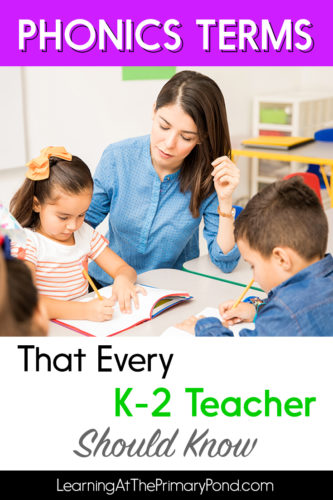


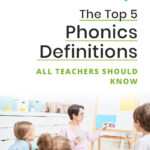


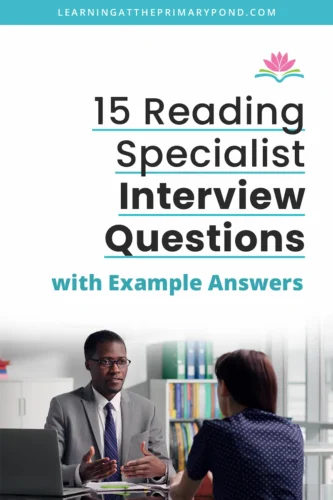
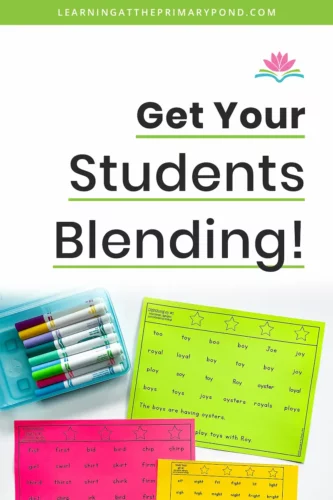
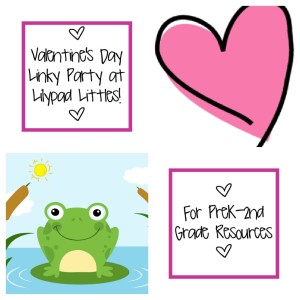






This was amazing! Thank-you! I’m homeschooling my son and trying to learn all these terms has been difficult. Your post explained everything so clearly. Thank-you!
You are so welcome! 🙂
Help! My children seem to struggle with N and E. In particular they hear the initial short e sound when you pronounce the letter N “en”. So, when they see an N they want to say a short /e/. Is there a way that I can teach this better? I want to note that if I say /n/ they recognize that the letter name is N.
Hey! This is such a great question – and makes total sense why they are getting confused! My main suggestion is just to spend more time practicing the letter sounds (with a big focus on the confusing ones!) than you do letter names, at least for a while. Some quick flashcards, a chant, BINGO, games – just repetition and time should help.